

| EHHRC Home | About the EHHRC | Invasive Species | Noxious Plants | Trail Maint. Photos |
|---|---|---|---|---|
| Canoe/Kayak | Town of East Hartford | Safety Tips | Contact Us |
Japanese Knotweed
For additional information on Japanese Knotweed click on:
Japanese Knotweed.
For additional information on Phragmites click on: Phragmites.
For additional information on Russian Olive click on:
Russian Olive.
Japanese Barberry
For additional information on Japanese Barberry click on:
Japanese Barberry.
"Mile-a-Minute" Vine
For additional information on the "Mile-a-Minute" vine, click on:
Mile-a-Minute.
Oriental Bittersweet
For additional information on Oriental Bittersweet click on:
Oriental Bittersweet.
Purple Loosestrife
For additional information on Purple Loosestrife click on:
Purple Loosestrife.
Water Chestnut
For additional information on Water Chestnut click on:
Water Chestnut.
Garlic Mustard
For additional information on Garlic Mustard click on:
Garlic Mustard.
Multiflora Rose
For additional information on Multiflora Rose click on:
Multiflora Rose.
Invasive Species are plants or animals which are not native to an ecological area but which are introduced to it,
either by accident or design, and which tend to displace native species due to aggressive reproduction, a lack of natural
enemies, or both.
Along the Hockanum River, our concern is with invasive plants, the most common of which are described below. Note
that while a sample Web page is provided, you can find additional information by typing the name of the plant into a
standard Web search engine such as Google.
NOTE: An exception to this involves recent sightings of the Asian Longhorned Beetle, which attacks hardwood
trees and has recently been found in Worcester, MA. Information on the Asian Longhorned Beetle can be accessed from
TreeHelp.com by clicking here.
Another recent exception is the Emerald Ash Borer, which attacks ash trees and is the subject of quarantine efforts in
many states. Information on the Emerald Ash Borer can be found by clicking this
Emerald Ash Borer website, and this one EAB - CT from the CT Department of
Energy and Environmental Protection.
Yet another exception is the red-eared slider turtle, an invasive species popular as pets and, unfortunately,
often released to the wild. As pointed out in a
July 22, 2016 edition of the Journal Inquirer, these turtles are larger and can reproduce faster than native
species. For additional information on red-eared slider turtles, click the following article from
wikipedia.
 Japanese Knotweed is an upright, shrublike perennial with a bamboo-like stem which can reach up to 10 feet in height.
Leaf sizes will vary, but are normally about 6 inches long by 3-4 inches wide, broadly oval to somewhat triangular, and
pointed at the tip. Knotweed spreads quickly to form dense thickets that exclude native vegetation and greatly alter
natural ecosystems. It poses a significant threat to riverbank areas, where it can survive floods and is able to rapidly
colonize scoured shores and islands.
Japanese Knotweed is an upright, shrublike perennial with a bamboo-like stem which can reach up to 10 feet in height.
Leaf sizes will vary, but are normally about 6 inches long by 3-4 inches wide, broadly oval to somewhat triangular, and
pointed at the tip. Knotweed spreads quickly to form dense thickets that exclude native vegetation and greatly alter
natural ecosystems. It poses a significant threat to riverbank areas, where it can survive floods and is able to rapidly
colonize scoured shores and islands.
Phragmites
 Phragmites is a tall perennial grass, known locally as the "common reed." It can grow up to 14 feet high and has a stiff,
hollow stem; and has feathery and drooping clusters of tiny flowers which can be purplish or white/gray depending on the
season. Phragmites is capable of forming large stands or colonies arising from a few seeds of plant pieces, along the
margins of marshes and streams. Their aggressive growth and tendency to out-compete other species has many
conservationists worried.
Phragmites is a tall perennial grass, known locally as the "common reed." It can grow up to 14 feet high and has a stiff,
hollow stem; and has feathery and drooping clusters of tiny flowers which can be purplish or white/gray depending on the
season. Phragmites is capable of forming large stands or colonies arising from a few seeds of plant pieces, along the
margins of marshes and streams. Their aggressive growth and tendency to out-compete other species has many
conservationists worried.
Russian Olive
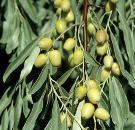 Russian Olive, also known as Autumn Olive, is a small, usually thorny shrub or small tree, which can grow up to 30 feet in
height. Its stems, buds and leaves have a dense covering of silvery to rusty scales. It is able to out-compete native
vegetation, interfere with natural plant and nutrient cycling, and tax water reserves. Because it is able to fix nitrogen,
it can grow on bare mineral substrates and can come to dominate riverside areas.
Russian Olive, also known as Autumn Olive, is a small, usually thorny shrub or small tree, which can grow up to 30 feet in
height. Its stems, buds and leaves have a dense covering of silvery to rusty scales. It is able to out-compete native
vegetation, interfere with natural plant and nutrient cycling, and tax water reserves. Because it is able to fix nitrogen,
it can grow on bare mineral substrates and can come to dominate riverside areas.
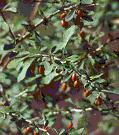 Japanese Barberry is a dense, deciduous spiny shrub that grows 2-8 feet high. The branches are brown, deeply grooved,
somewhat zigzag in form, and grow a single, very sharp spine at each node. The leaves are small, oval to spatual shaped,
and are green, bluish-green, or dark red-purple. It is shade-tolerant and drought-resistant. It forms dense stands in
natural habitats, including canopy forests, open woodlands, wetlands, pastures and meadows; and alters soil pH, nitrogen
levels, and biological activity. Once established it displaces native plants and reduces native wildlife and forage.
White-tail deer apparently avoid browsing barberry, preferring native plants and thus giving Japanese Barberry a
competitive advantage.
Japanese Barberry is a dense, deciduous spiny shrub that grows 2-8 feet high. The branches are brown, deeply grooved,
somewhat zigzag in form, and grow a single, very sharp spine at each node. The leaves are small, oval to spatual shaped,
and are green, bluish-green, or dark red-purple. It is shade-tolerant and drought-resistant. It forms dense stands in
natural habitats, including canopy forests, open woodlands, wetlands, pastures and meadows; and alters soil pH, nitrogen
levels, and biological activity. Once established it displaces native plants and reduces native wildlife and forage.
White-tail deer apparently avoid browsing barberry, preferring native plants and thus giving Japanese Barberry a
competitive advantage.
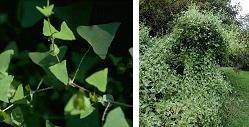 The "mile-a-minute" vine has triangular leaves with three sides and no lobes, small but sharp barbs along the stem, and
small, saucer-shaped leaves found at branching points on the stem. This vine is a highly-invasive plant from eastern Asia
that can quickly out-compete and replace native vegetation. The vine has been found in over 20 towns in Connecticut.
Everyone is urged to call DEEP if they find a mile-a-minute anywhere, before pulling it up, as additional
information on the plants and their surroundings may be needed.
The "mile-a-minute" vine has triangular leaves with three sides and no lobes, small but sharp barbs along the stem, and
small, saucer-shaped leaves found at branching points on the stem. This vine is a highly-invasive plant from eastern Asia
that can quickly out-compete and replace native vegetation. The vine has been found in over 20 towns in Connecticut.
Everyone is urged to call DEEP if they find a mile-a-minute anywhere, before pulling it up, as additional
information on the plants and their surroundings may be needed.
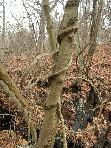
Oriental Bittersweet is a deciduous, climbing and woody vine reaching up to 60 feet in length, which infests tree crowns
and forms thicket and arbor infestations. The vine can be up to 4 inches in diameter, twining among the tree
branches and creating many alternate drooping branches initially going at various angles but eventually growing straight.
It occurs in a wide range of sites, but mainly along forest edges; and can be found as scattered plants on up through
extensive infestations. It colonizes by prolific vine growth and seedlings.
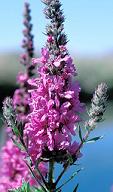 Purple Loosestrife is an erect perennial herb with a square, woody stem and whorled leaves. The plants are usually covered
by a downy pubescence. Loosestrife plants grow from 4-10 feet high, and produce a showy display of magenta-colored flower
spikes throughout much of the summer. Mature plants can have 30-50 stems arising from a single rootstock. It readily
adapts to natural and disturbed wetlands, and as it expands it outcompetes and replaces native grasses, sedges and other
flowering plants that provide a higher-quality source of nutrition for wildlife. Its highly invasive nature allows it to
form dense, homogeneous stands that restrict native wetland species, including some federally endangered orchids, and
reduce habitat for waterfowl.
Purple Loosestrife is an erect perennial herb with a square, woody stem and whorled leaves. The plants are usually covered
by a downy pubescence. Loosestrife plants grow from 4-10 feet high, and produce a showy display of magenta-colored flower
spikes throughout much of the summer. Mature plants can have 30-50 stems arising from a single rootstock. It readily
adapts to natural and disturbed wetlands, and as it expands it outcompetes and replaces native grasses, sedges and other
flowering plants that provide a higher-quality source of nutrition for wildlife. Its highly invasive nature allows it to
form dense, homogeneous stands that restrict native wetland species, including some federally endangered orchids, and
reduce habitat for waterfowl.
For information on a project from the University of Connecticut using beetles to battle Loosestrife click on:
Beetles vs Loosestrife
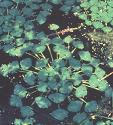 Water chestnut is a rooted, aquatic plant with both floating and submersed leaves. The floating leaves form a rosette, and
are green, glossy, and triangular with toothed edges. The submersed leaves are feathery, and are found whorled around the
stem. Plant stems are cord-like, and can attain a length of 16 feet. The dense growth of the water chestnut can
effectively choke a waterbody, making boating, fishing and swimming nearly impossible. The weed also shades out native
aquatic plants, and offers little value to wildlife. The seeds have sharp spines that can inflict puncture wounds. Early
detection is critical to its control: while small infestations can be controlled manually (by pulling out the individual
plants), large infestations require the use of mechanical harvesters.
Water chestnut is a rooted, aquatic plant with both floating and submersed leaves. The floating leaves form a rosette, and
are green, glossy, and triangular with toothed edges. The submersed leaves are feathery, and are found whorled around the
stem. Plant stems are cord-like, and can attain a length of 16 feet. The dense growth of the water chestnut can
effectively choke a waterbody, making boating, fishing and swimming nearly impossible. The weed also shades out native
aquatic plants, and offers little value to wildlife. The seeds have sharp spines that can inflict puncture wounds. Early
detection is critical to its control: while small infestations can be controlled manually (by pulling out the individual
plants), large infestations require the use of mechanical harvesters.
 Garlic Mustard is a cool season biennial herb with stalked, triangular to heart-shaped, coarsely-toothed leaves that give
off an odor of garlic when crushed. It poses a severe threat to native plants and animals in forest communities in much
of the eastern and midwestern U.S. Once it is introduced into an area, Garlic Mustard outcompetes native plants by
aggressively monopolizing light, moisture, nutrients, soil and space. Moreover, at least 1 insect, the West Virginia White
Butterfly, is threatened by it as chemicals in this plant appear toxic to the butterfly's larval stage. Garlic Mustard
frequently occurs in moist, shaded soil of river floodplains, forests, roadsides, edges of woods and trail edges, and
forest openings. Disturbed areas are most susceptible to rapid invasion and dominance.
Garlic Mustard is a cool season biennial herb with stalked, triangular to heart-shaped, coarsely-toothed leaves that give
off an odor of garlic when crushed. It poses a severe threat to native plants and animals in forest communities in much
of the eastern and midwestern U.S. Once it is introduced into an area, Garlic Mustard outcompetes native plants by
aggressively monopolizing light, moisture, nutrients, soil and space. Moreover, at least 1 insect, the West Virginia White
Butterfly, is threatened by it as chemicals in this plant appear toxic to the butterfly's larval stage. Garlic Mustard
frequently occurs in moist, shaded soil of river floodplains, forests, roadsides, edges of woods and trail edges, and
forest openings. Disturbed areas are most susceptible to rapid invasion and dominance.
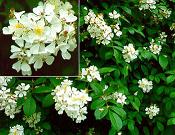 Multiflora Rose is a thorny, perennial shrub with arching stems (canes) and leaves divided into 5 to 11 sharply toothed
leaflets. The base of each leaf stalk bears a pair of fringed bracts (leaflets). It is extremely prolific and can form
impenetrable thickets that exclude native plant species. It readily invades open woodlands, forest edges, successional
fields, savannas and prairies that have been subjected to land disturbance. It has a wide tolerance for soil, moisture,
and light conditions. While initially introduced in part to act as a "living fence" on farms and even highway median
strips, its tenacious and unstoppable growth habit was eventually recognized as a problem on pastures and unplowed lands
where it disrupted cattle grazing.
Multiflora Rose is a thorny, perennial shrub with arching stems (canes) and leaves divided into 5 to 11 sharply toothed
leaflets. The base of each leaf stalk bears a pair of fringed bracts (leaflets). It is extremely prolific and can form
impenetrable thickets that exclude native plant species. It readily invades open woodlands, forest edges, successional
fields, savannas and prairies that have been subjected to land disturbance. It has a wide tolerance for soil, moisture,
and light conditions. While initially introduced in part to act as a "living fence" on farms and even highway median
strips, its tenacious and unstoppable growth habit was eventually recognized as a problem on pastures and unplowed lands
where it disrupted cattle grazing.